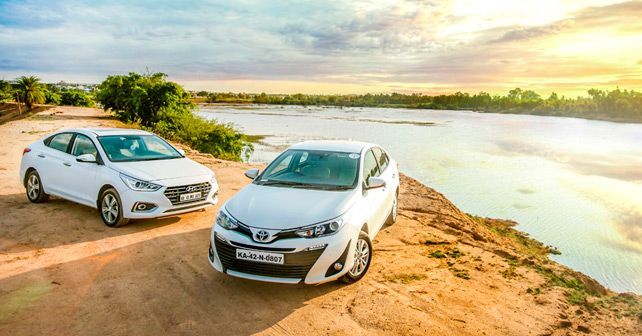The brand new Yaris must compete with the stalwarts in the segment – the Honda City and Maruti Suzuki Ciaz – but first it must take on the current Indian Car of the Year, the Hyundai Verna.
A shootout between the Toyota Yaris and Hyundai Verna is a no-brainer. After all, both cars have similar dimensions and compete in the same segment. But, when you pay close attention to both cars, it becomes quite apparent that they each have a very different nature.
What about style?
Just to put it into perspective, the Yaris offers a typical Toyota package – one that’s well suited to those who prefer to be chauffeured in an urban environment. In terms of design, it’s typical Toyota, which simply means that it’s sleek but with nothing that will really make it stand out. The Verna, however, features Hyundai’s latest iteration of its Fluidic design language and is actually quite a handsome car. It certainly looks unique, upmarket even.
On the inside too, the Verna is more attractive. Its large multimedia system stands out, especially since it offers a seamless interface, along with Apple CarPlay and Android Auto. Also, it has ventilated front seats (a segment-first feature), which is a blessing considering the climate in the majority of our country.
All about space
However, when it comes to cabin space, the Yaris is simply in another league. Not only does it have a lot more rear legroom – the Verna’s rear seat is cramped at best – but the cabin feels roomier on the whole. Also, the Yaris’s roof mounted rear air vents add to an overall sense of comfort.
The power of choice
The fundamental difference between these two cars presents itself in the form of their respective engine options. The Verna caters to a far wider audience, with two petrol and one diesel engine on offer. The Yaris offers only a 1.5-litre petrol engine – but it does have an automatic transmission available on all trim versions, something that the Verna lacks. The Verna offers automatic transmissions on just two trims levels in both the diesel and petrol models. Plus, the Verna is surpassed in terms of safety features too – as the Yaris features seven airbags as standard across all variants, while the Verna features dual airbags on most trim levels, with only the top end SX(O) trim offering six airbags as standard.
Driving appeal
From behind the wheel, it’s immediately clear that the Verna, with its well-sorted dynamics, completely outshines the Yaris. Its steering is direct, with decent feel, while the suspension is well tuned for road holding. It offers a slightly firm ride, but one that provides a sense of assurance and inspires confidence in the chassis. And while the Yaris does ride very well, it’s completely devoid of any sense of driving appeal. So, again, if you’re chauffeured, you’ll certainly prefer the extra compliance provided by the Toyota, but once in the driver’s seat there’s simply no contest – with its tighter body control and rewarding driving dynamics, the Verna is the clear winner from behind the wheel.
Which one to choose?
To be honest, I think the Yaris and Verna are pretty good cars in their own right – the choice of one over the other would depend entirely on usage. If the primary function of the car is to go from A-to-B in the city in the most comfortable way possible, the Yaris, with its CVT automatic transmission and airy cabin, would be perfect. Plus, of course, thanks to brilliant air conditioning and excellent ride quality, it’s certainly better suited when it comes to rear seat comfort.
On the other hand, if you’re looking for even an iota of desire or driving appeal, it’s the Verna that you want. This is not a car in which you want to be confined to the cramped rear seat though – this is very much the driver’s car of the two. It’s not only stylish, but provides a driving experience to match. Moreover, a better integrated infotainment system and a more appealing driver environment means that you won’t regret your decision to get behind the wheel – especially when you decide, on occasion, to chuck it into a corner. And if it’s highway miles that you’ll be covering, then the Verna has you covered with a diesel option as well. Lastly, it’s got a far more responsive torque converter automatic transmission (versus a CVT in the Yaris) – which is available in both petrol and diesel models.
And while the Yaris offers plenty of space and comfort, be willing to pay quite a premium. The top-end Yaris CVT – with LED DRLs, electrically adjustable leather seats, navigation and gesture control – is 14.07-lakh (ex-showroom), versus the top-of-the-line 1.6-litre 6-speed AT Verna, which is priced considerably less at 12.55-lakh (ex-showroom). Keep in mind that, in the 1.6 Verna, you get more performance as well (121 horsepower versus 106). So, if you’re driving yourself, it’s a no-brainer – the Verna comes out on top. But if you’re being chauffeured, the Yaris certainly is the better choice – but it will cost you!




























Write your Comment